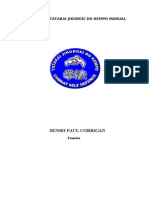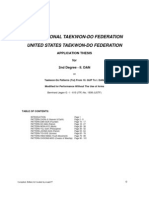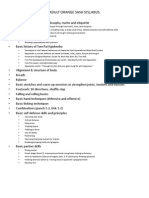0 ratings0% found this document useful (0 votes)
118 viewsTheory of Power
Theory of Power
Uploaded by
tomjonespageChoi's Theory of Power, which is fundamental to taekwondo practice, is based on biomechanics and Newtonian physics. It holds that power increases quadratically with speed rather than linearly with mass. This emphasizes speed over size in generating power. The theory also advocates relaxing the body between techniques and tensing only during the technique to conserve energy. It incorporates concepts like reaction force, concentration of muscles, maintaining equilibrium, breath control, using full body mass, and emphasizing speed through acceleration rather than deceleration.
Copyright:
© All Rights Reserved
Available Formats
Download as TXT, PDF, TXT or read online from Scribd
Theory of Power
Theory of Power
Uploaded by
tomjonespage0 ratings0% found this document useful (0 votes)
118 views1 pageChoi's Theory of Power, which is fundamental to taekwondo practice, is based on biomechanics and Newtonian physics. It holds that power increases quadratically with speed rather than linearly with mass. This emphasizes speed over size in generating power. The theory also advocates relaxing the body between techniques and tensing only during the technique to conserve energy. It incorporates concepts like reaction force, concentration of muscles, maintaining equilibrium, breath control, using full body mass, and emphasizing speed through acceleration rather than deceleration.
Original Description:
TKD power ideas
Copyright
© © All Rights Reserved
Available Formats
TXT, PDF, TXT or read online from Scribd
Share this document
Did you find this document useful?
Is this content inappropriate?
Choi's Theory of Power, which is fundamental to taekwondo practice, is based on biomechanics and Newtonian physics. It holds that power increases quadratically with speed rather than linearly with mass. This emphasizes speed over size in generating power. The theory also advocates relaxing the body between techniques and tensing only during the technique to conserve energy. It incorporates concepts like reaction force, concentration of muscles, maintaining equilibrium, breath control, using full body mass, and emphasizing speed through acceleration rather than deceleration.
Copyright:
© All Rights Reserved
Available Formats
Download as TXT, PDF, TXT or read online from Scribd
Download as txt, pdf, or txt
0 ratings0% found this document useful (0 votes)
118 views1 pageTheory of Power
Theory of Power
Uploaded by
tomjonespageChoi's Theory of Power, which is fundamental to taekwondo practice, is based on biomechanics and Newtonian physics. It holds that power increases quadratically with speed rather than linearly with mass. This emphasizes speed over size in generating power. The theory also advocates relaxing the body between techniques and tensing only during the technique to conserve energy. It incorporates concepts like reaction force, concentration of muscles, maintaining equilibrium, breath control, using full body mass, and emphasizing speed through acceleration rather than deceleration.
Copyright:
© All Rights Reserved
Available Formats
Download as TXT, PDF, TXT or read online from Scribd
Download as txt, pdf, or txt
You are on page 1of 1
Theory of Power[edit]
This emphasis on speed and agility is a defining characteristic of taekwondo and
has its origins in analyses undertaken by Choi Hong Hi. The results of that ana
lysis are known by ITF practitioners as Choi's Theory of Power. Choi's Theory of
Power is based on biomechanics and Newtonian physics. For example, Choi observe
d that the power of a strike increases quadratically with the speed of the strik
e, but increases only linearly with the mass of the striking object. In other wo
rds, speed is more important than size in terms of generating power. This princi
ple was incorporated into the early design of taekwondo and is still used. [2] [
8]
Choi also advocated a relax / strike principle for taekwondo; in other words, be
tween blocks, kicks, and strikes the practitioner should relax the body, then te
nse the muscles only while performing the technique. It is believed that this to
o increases the power of the technique, by conserving the body's energy. He expa
nded on this principle with his advocacy of the sine wave technique. This involv
es raising one's center of gravity between techniques, then lowering it as the t
echnique is performed, producing the up-and-down movement from which the term "s
ine wave" is derived. [8] The sine wave is generally practiced, however, only in
some schools that follow ITF-style taekwondo. Kukkiwon-style taekwondo, for exa
mple, does not employ the sine wave and instead advocates a more uniform height
during movements (i.e. karate).
The components of the Theory of Power include:[9]
Reaction Force - the principle that as the striking limb is brought forward, oth
er parts of the body should be brought backward in order to provide more power t
o the striking limb. As an example, if the right leg is brought forward in a rou
ndhouse kick, the right arm is brought backward to provide the reaction force.
Concentration - focusing the mind and body together to make the technique more p
owerful, with the principle of bringing as many muscles as possible to bear on a
strike, concentrating the area of impact into as small an area as possible
Equilibrium - wide long stances of ITF style taekwondo as taught by General Choi
require increased emphasis on maintaining a correct center-of-balance throughou
t a technique. WTF style Shorter unbalanced stances for quicker dropping kicking
techniques.
Breath Control - the idea that during a strike one should exhale, with the exhal
ation concluding at the moment of impact
Mass - the principle of bringing as much of the body to bear on a strike as poss
ible; again using the turning kick as an example, the idea would be to rotate th
e hip as well as the leg during the kick in order to take advantage of the hip's
additional mass in terms of providing power to the kick
Speed - is classed as the acceleration of a technique where it continues passed
the point of the target and doesn't de-accelerate.
You might also like
- Rhee Taekwon-Do Curriculum Unofficial and UnauthorisedDocument43 pagesRhee Taekwon-Do Curriculum Unofficial and UnauthorisedPaulNo ratings yet
- Sandow on physical training: A study in the perfect type of the human formFrom EverandSandow on physical training: A study in the perfect type of the human formNo ratings yet
- U-Nam TulDocument17 pagesU-Nam Tulsaipol100% (1)
- 1 TJDDocument19 pages1 TJDjbsimha3629No ratings yet
- No Gi Chokes Ebook PDFDocument45 pagesNo Gi Chokes Ebook PDFdiamond68100% (1)
- Nunchaku SetDocument3 pagesNunchaku Setnear600No ratings yet
- Head of CourtDocument1 pageHead of CourtJOHN BEBON YAP100% (1)
- Kosen RulesDocument6 pagesKosen Rulesdiamond68No ratings yet
- Cabra Kai - White To Blue SyllabusDocument1 pageCabra Kai - White To Blue SyllabusMuhammad Irfan RiazNo ratings yet
- 2014 Brazilian Jiu-Jitsu CatalogDocument48 pages2014 Brazilian Jiu-Jitsu CatalogCentury IT100% (1)
- 1tong Il Moo Do Manual Sbornik PDFDocument191 pages1tong Il Moo Do Manual Sbornik PDFСергей ФоминNo ratings yet
- Naihanchi Mook Jong PDFDocument13 pagesNaihanchi Mook Jong PDFwakasensei99No ratings yet
- BJJ - Roy Harris - Escape From The SiDocument30 pagesBJJ - Roy Harris - Escape From The Siartsmartiauxtunisie100% (1)
- Arm Drag Summary ComicDocument24 pagesArm Drag Summary ComiclutherNo ratings yet
- Aafricap's Capoeira Manual - MovementsDocument11 pagesAafricap's Capoeira Manual - MovementsRyan SutherlandNo ratings yet
- Martial SparksDocument394 pagesMartial SparksRoope SalmiNo ratings yet
- Hapkido Tech To NeutralizDocument0 pagesHapkido Tech To NeutraliznitrofrogNo ratings yet
- Budoshin Ju Jitsu SyllabusDocument3 pagesBudoshin Ju Jitsu SyllabusanthonyspinellijrNo ratings yet
- StudentmanualDocument32 pagesStudentmanualAslyn WoodfordNo ratings yet
- Tournament Rules: International Taekwon-Do FederationDocument50 pagesTournament Rules: International Taekwon-Do FederationDiego Blanco100% (1)
- GraduationIBJJF en Vs2Document19 pagesGraduationIBJJF en Vs2Allene Somar100% (1)
- Alternative MakiwaraDocument1 pageAlternative MakiwaraR-x DasNo ratings yet
- SESTKD 1-1-000 Student Training Guide 2020Document20 pagesSESTKD 1-1-000 Student Training Guide 2020Pedro Póvoa OlyNo ratings yet
- Aikido TermsDocument2 pagesAikido TermsAndrew MedalNo ratings yet
- Vol 14 TKDDocument376 pagesVol 14 TKDAli AlzahraniNo ratings yet
- A History of Savate, Chausson An French Boxing (1828-1978) - A Short Story For A Long PastDocument30 pagesA History of Savate, Chausson An French Boxing (1828-1978) - A Short Story For A Long PastIgor DoiNo ratings yet
- Chin Na Grading ListDocument2 pagesChin Na Grading ListRonaldo BriantNo ratings yet
- TaiotoshiDocument4 pagesTaiotoshiYuda Navyy SatriaNo ratings yet
- Roku Dan ReportDocument20 pagesRoku Dan ReportbambangijoNo ratings yet
- 11 Hwarang Do en InglesDocument3 pages11 Hwarang Do en Inglesjanali69100% (1)
- Adult Manuals (1) VKKSDocument123 pagesAdult Manuals (1) VKKSPedro PaezNo ratings yet
- 36 39Document4 pages36 39Hector Diaz100% (1)
- Master Cycle - Blue Belt Stripe 1: Chapter 7.4: Clinch/Takedowns Technique: Double Leg CounterDocument1 pageMaster Cycle - Blue Belt Stripe 1: Chapter 7.4: Clinch/Takedowns Technique: Double Leg CounterRobson Tarifa NavarroNo ratings yet
- Theory For Black Belt GradingsDocument0 pagesTheory For Black Belt GradingsHaider UsmanNo ratings yet
- H2HDocument5 pagesH2HmarcitectNo ratings yet
- Everlast 2009 Spring CatalogDocument108 pagesEverlast 2009 Spring Catalogbeaulangdon100% (1)
- WKSA Student HandbookDocument20 pagesWKSA Student HandbookLutfi MuhammadNo ratings yet
- Syllabus BinderDocument20 pagesSyllabus BinderNoel GilchristNo ratings yet
- Ozark JKD CertificateDocument1 pageOzark JKD Certificatejkd01No ratings yet
- ITF Armless TulsDocument102 pagesITF Armless TulssaipolNo ratings yet
- E0q8aNXRS4LISzkyJkhA Positional Domination - Mount Maintenance PDFDocument11 pagesE0q8aNXRS4LISzkyJkhA Positional Domination - Mount Maintenance PDFΟρεστης ΝαλμπαντηςNo ratings yet
- Ed532181 PDFDocument20 pagesEd532181 PDFBrandy MaloneNo ratings yet
- 1 Orange SashDocument2 pages1 Orange Sashapi-72835672No ratings yet
- Standing JudoDocument2 pagesStanding JudoDr Banic Branislav100% (1)
- Apostila Ju-Jutsu - Inglês PDFDocument19 pagesApostila Ju-Jutsu - Inglês PDFDe DunkxNo ratings yet
- Student HandbookDocument26 pagesStudent HandbookChetanya MundachaliNo ratings yet
- Cultural Diffusion Project BJJDocument12 pagesCultural Diffusion Project BJJSteven FrazierNo ratings yet
- TITLE Boxing Summer 2010 Equipment CatalogDocument204 pagesTITLE Boxing Summer 2010 Equipment Catalogbeaulangdon100% (1)
- Tech Manual InstructorDocument45 pagesTech Manual InstructorWuilmer B. GuerreroNo ratings yet
- The Gospel According To KarateDocument4 pagesThe Gospel According To KaratecoultershaneNo ratings yet
- Traditional Value of KudoDocument4 pagesTraditional Value of Kudodcamu37No ratings yet
- Throw Any KickerDocument0 pagesThrow Any KickernitrofrogNo ratings yet
- Choi, Hong Hi-Encyclopedia of Taekwon-Do. Vol 10 PDFDocument283 pagesChoi, Hong Hi-Encyclopedia of Taekwon-Do. Vol 10 PDFRa RaNo ratings yet
- Wing ChunDocument15 pagesWing Chunnivra85No ratings yet
- 8 Ways to Benefit from Critique and Testing in the Martial Arts: The Power Trip: How to Survive and Thrive in the Dojo, #5From Everand8 Ways to Benefit from Critique and Testing in the Martial Arts: The Power Trip: How to Survive and Thrive in the Dojo, #5No ratings yet
- Physical Preparation: Formidable Fighter, #2From EverandPhysical Preparation: Formidable Fighter, #2Rating: 1 out of 5 stars1/5 (1)
- Fox News Retracts Seth Rich Conspiracy Story As Hannity Vows To Press On Christopher Wilson 4 Hours Ago - ? ReactionsDocument8 pagesFox News Retracts Seth Rich Conspiracy Story As Hannity Vows To Press On Christopher Wilson 4 Hours Ago - ? ReactionstomjonespageNo ratings yet
- GFHJJCDocument6 pagesGFHJJCtomjonespageNo ratings yet
- M Morningfinance - Lendingtree QuotessponsoredDocument8 pagesM Morningfinance - Lendingtree QuotessponsoredtomjonespageNo ratings yet
- Recently Viewed Your List Is EmptyDocument9 pagesRecently Viewed Your List Is EmptytomjonespageNo ratings yet
- Marie ClaireDocument8 pagesMarie ClairetomjonespageNo ratings yet
- REQ - Rob Faigin BooksDocument2 pagesREQ - Rob Faigin BookstomjonespageNo ratings yet
- Book DetailsDocument6 pagesBook DetailstomjonespageNo ratings yet
- Creative Creative Nonfiction Essays Memoirs On Writing - Poetry - Book DetailsDocument5 pagesCreative Creative Nonfiction Essays Memoirs On Writing - Poetry - Book DetailstomjonespageNo ratings yet
- Creative Nonfiction Essays Memoirs On Writing - Poetry - Book DetailsDocument3 pagesCreative Nonfiction Essays Memoirs On Writing - Poetry - Book DetailstomjonespageNo ratings yet
- Summary of Changes: Location ChangeDocument9 pagesSummary of Changes: Location ChangesilvanopipeNo ratings yet
- Module 4 - WORK, ENERGY AND POWERDocument20 pagesModule 4 - WORK, ENERGY AND POWERHanah ArzNo ratings yet
- MEC 309 Chapter 6 FormulasDocument2 pagesMEC 309 Chapter 6 Formulasthetannies0613No ratings yet
- Kisssoft Tut 003 E KeyDocument11 pagesKisssoft Tut 003 E KeydenisNo ratings yet
- Valery P. Dmitriyev - Elasticity and ElectromagnetismDocument10 pagesValery P. Dmitriyev - Elasticity and Electromagnetism939392No ratings yet
- Literature Review of RotorDocument120 pagesLiterature Review of RotorMojtaba Hasanlu100% (1)
- L11 - Force Method PDFDocument11 pagesL11 - Force Method PDFBondanAsmoroNo ratings yet
- P IpesDocument15 pagesP IpesMelvin EsguerraNo ratings yet
- Mech Nonlin Mats 14.5 L01 Adv PlasticityDocument28 pagesMech Nonlin Mats 14.5 L01 Adv PlasticityRao JanapaNo ratings yet
- 5054 w08 Ms 2Document6 pages5054 w08 Ms 2mstudy123456No ratings yet
- Handbook of X Ray Photoelectron Spectroscopy 1995 PDFDocument51 pagesHandbook of X Ray Photoelectron Spectroscopy 1995 PDFSandra Milena Londoño RNo ratings yet
- Reinforced Concrete Design by Professor Anthony Kwame DansoDocument131 pagesReinforced Concrete Design by Professor Anthony Kwame DansoBadu Evans NyiayeNo ratings yet
- University of Waterloo Physics 115 Final ExamDocument13 pagesUniversity of Waterloo Physics 115 Final ExamAashish GauravNo ratings yet
- MagnetismDocument42 pagesMagnetismNurul Afida TahirNo ratings yet
- Name: - Course, Year & Section: - General Instructions: Answer The Following Questions Based On Our PreviousDocument2 pagesName: - Course, Year & Section: - General Instructions: Answer The Following Questions Based On Our PreviousCarlo CabanusNo ratings yet
- Postal: Ese + Gate + PsusDocument3 pagesPostal: Ese + Gate + PsusRamsai ChigurupatiNo ratings yet
- Viscosity and Surface TensionDocument15 pagesViscosity and Surface TensionAtul KumarNo ratings yet
- Capitulo 3 de Libro Heat Exchanger Design HandbookDocument3 pagesCapitulo 3 de Libro Heat Exchanger Design HandbookJOSE RICARDO DURANNo ratings yet
- Analysis of Building Frames With Semi-Rigid ConnectionsDocument1 pageAnalysis of Building Frames With Semi-Rigid Connectionstuyul id39No ratings yet
- Exp4 - Dynamic Response in 2nd Order System For Step ChangeDocument13 pagesExp4 - Dynamic Response in 2nd Order System For Step ChangeTANYA PRIYADARSHNINo ratings yet
- Split-Beam Tee Connections-Prying ActionDocument27 pagesSplit-Beam Tee Connections-Prying ActionKaren JoyNo ratings yet
- CE2155 - Stress and Strain Transformation (Part 1)Document44 pagesCE2155 - Stress and Strain Transformation (Part 1)JuliaNo ratings yet
- Dynamic Analysis of Three-Roll Pyramidal Configuration Roll Bending Process and Experimental VerificationDocument7 pagesDynamic Analysis of Three-Roll Pyramidal Configuration Roll Bending Process and Experimental Verificationdesign mosNo ratings yet
- A Level Further Mathematics For AQA Mechanics Student Book 1 (AS/A Level) Scheme of WorkDocument23 pagesA Level Further Mathematics For AQA Mechanics Student Book 1 (AS/A Level) Scheme of WorkBibi100% (1)
- CLS Aipmt-19-20 XI Phy Study-Package-5 Level-1 Chapter-11 PDFDocument20 pagesCLS Aipmt-19-20 XI Phy Study-Package-5 Level-1 Chapter-11 PDFAmaan HingoraNo ratings yet
- International Conference On "Structural Engineering & Construction Management" SECM-2016Document8 pagesInternational Conference On "Structural Engineering & Construction Management" SECM-2016VishwanadhNo ratings yet
- Lecture Notes - CamsDocument5 pagesLecture Notes - CamsJohn Lloyd A. VincoyNo ratings yet
- Dynamic Pile Load TestingDocument35 pagesDynamic Pile Load TestingdoeljamNo ratings yet
- Savings in Work DoneDocument8 pagesSavings in Work DoneseemasainiNo ratings yet
- Design of Built Up Plate Girders - p1 - 2perDocument56 pagesDesign of Built Up Plate Girders - p1 - 2perLuis CortesNo ratings yet


































































































